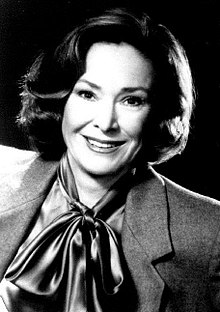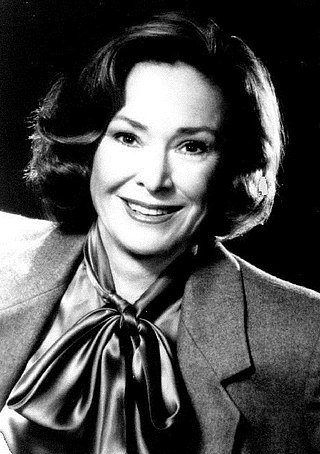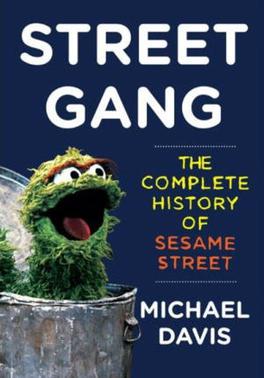Critical reception
Sesame Street was praised from its debut in 1969. Newsday reported that several newspapers and magazines had written "glowing" reports about CTW and co-creator Joan Ganz Cooney. [28] Although the series had been on the air for less than a year, Time Magazine featured Big Bird, who had received more fan mail than any of the show's human hosts, on its cover and declared, " ...It is not only the best children's show in TV history, it is one of the best parents' shows as well". [29] The press overwhelmingly praised the new show; several popular magazines and niche magazines lauded it. [30] A 2010 survey found that most parents supported their children's viewing of Sesame Street and other PBS educational shows, and many educators used them as aides in the classroom. [31]
"Sesame Street is...with lapses, the most intelligent and important program in television. That is not anything much yet".
-Renata Adler, The New Yorker, 1972 [32]
David Frost declared Sesame Street "a hit everywhere it goes". [29] An executive at ABC, while recognizing that Sesame Street was not perfect, stated that the show "opened children's TV to taste and wit and substance"... and "made the climate right for improvement". [29] By the end of the show's first season, ratings were high, the song "Rubber Duckie" was on the music charts for nine weeks, and Big Bird appeared on The Flip Wilson Show . Also in 1970, Sesame Street won twenty awards, including a Peabody Award, three Emmys, an award from the Public Relations Society of America, a Clio, and the Prix Jeunesse award. [33] President Richard Nixon sent Cooney a congratulatory letter. [29] Dr. Benjamin Spock predicted that the program would result in "better trained citizens, fewer unemployables in the next generation, fewer people on welfare, and smaller jail populations". [34] By 1995, the show had won two Peabody Awards and four Parents' Choice Awards. It was the subject of a traveling exhibition by the Smithsonian Institution, [35] and a film exhibition at the Museum of Modern Art. [36] In 2002, TV Guide ranked the show number 27 on its list of the best television shows of all time; [37] in 2013, TV Guide ranked the show number 30 on its list of the 60 best TV series. [38] Sesame Workshop won a Peabody Award in 2009 for its website, sesamestreet.org, [39] and the show was given Peabody's Institutional Award in 2019 for 50 years of educating and entertaining children globally. [40] As of 2018, Sesame Street has won 189 Emmys. [41]

Sesame Street was not without its detractors, however. In May 1970, a state commission in Mississippi voted to exclude to host the show on its state educational TV network owing to concerns over the show's inclusive racial message. A member of the commission told The New York Times, that "Mississippi was not yet ready" for the show's integrated cast. [42] Cooney called the commission's decision "a tragedy for both the white and black children of Mississippi". [15] The Mississippi commission later reversed its decision 22 days later, after the vote had made national news. [15]
According to Children and Television , Lesser's account of the development and early years of Sesame Street, there was little criticism of the show in the months following its premiere, but it increased at the end of its first season and beginning of the second season. Lesser put the early criticism into four categories: educational goals, how the goals were chosen and obtained, the show's possible unintended effects, and its portrayal of minorities and women. [43] [note 3] Historian Robert W. Morrow suggested that much of the early criticism, which he called "surprisingly intense", [44] stemmed from cultural and historical reasons in regards to, as he put it, "the place of children in American society and the controversies about television's effects on them". [44]
The "most important" [45] studies that found negative effects of Sesame Street were conducted by educator Herbert A. Sprigle and psychologist Thomas D. Cook during its first two seasons. Both studies found that the show increased the educational gap between poor and middle-class children. Morrow reported that these studies had little impact on the public discussion about Sesame Street. [46] Social scientist and Head Start founder Urie Bronfenbrenner criticized the show for being too wholesome, stating, "The old, the ugly or the unwanted is simply made to disappear through a manhole". [29] He also criticized the show for presenting bland and unrealistic characters, and for failing to teach children about social relationships and how to become a part of the society around them. [47] Psychologist Leon Eisenberg saw Sesame Street's urban setting as "superficial" and having little to do with the problems confronted by the inner-city child. [48]
Head Start director Edward Zigler was probably Sesame Street's most vocal critic in the show's early years. He withdrew Head Start's funding of the show, becoming the first of CTW's original investors to do so. Morrow suggested that the basis of Zigler's criticism was concern that the federal government would transfer their funding of Head Start to CTW. [49] Also according to Morrow, these studies were utilized by critics in Sesame Street's later years, especially by child development psychologists Jerome and Dorothy G. Singer, who insisted the television shortened children's attention spans, and by author Neil Postman in his book Amusing Ourselves to Death , who believed that television could not teach children. [50] Postman claimed that Sesame Street also introduced children to a shallow pop culture, undermined American education, and relieved parents of their responsibility of teaching their children how to read. [51]
Since federal funds had been used to produce the show, more segments of the population insisted upon being represented on Sesame Street. Morrow credited CTW's commitment to multiculturalism as one source for their conflicts with the leadership of minority groups, especially Latino groups and feminists. These conflicts were resolved when the CTW added or substituted offending segments and characters. By 1977, the cast consisted of two African American women, one of whom was single, two African American men, a Chicano man, two white men, an American Indian woman, a Puerto Rican woman, and a Deaf white woman. [52]

Latino groups criticized the show for the lack of Hispanic characters during its early years. [15] A committee of Hispanic activists, commissioned by the CTW in 1970, called Sesame Street "racist" and said that the show's bilingual aspects were of "poor quality and patronizing". [44] According to Morrow, Cooney admitted that the show's bilingual elements were "not well thought out". [53] By 1971, the CTW hired Hispanic actors, production staff, and researchers, and by the mid-70s, Morrow reported that "the show included Chicano and Puerto Rican cast members, films about Mexican holidays and foods, and cartoons that taught Spanish words". [54] In 1989, Sesame Street created a four-year "race relations curriculum" [55] that focused on introducing its viewers to various cultural backgrounds.
The New York Times reported that creating strong female characters "that make kids laugh, but not...as female stereotypes" [56] has been a challenge for the producers of Sesame Street. Davis reported that the National Organization for Women (NOW) expressed concerns that the show needed to be "less male-oriented". [29] Members of NOW were "rankled by the portrayal of Susan, whom they saw as a subservient, powerless dispenser of milk and cookies". [57] In the spring of 1970, Boston Globe columnist Ellen Goodman objected to what she considered Sesame Street's portrayal of women and girls as passive. In late 1970, the NOW threatened to boycott the show. [58] The show's producers satisfied these critics by making Susan a nurse and by hiring a female writer. [29]
According to Morrow, change regarding how women and girls were depicted on Sesame Street occurred slowly. CTW's research staff, which were mostly made up of women, worked with the mostly male production staff to raise their consciousnesses about how women and girls were portrayed in their scripts. [58] Another source of friction between the CTW and feminists were the lack of female Muppets, for which they held Jim Henson responsible, as well as his organization of all-male puppeteers, who tended to create male characters. The demanding production schedule tended to attract only men, and Henson expressed his opinion that women were incapable of withstanding it. Gikow believed that the difficulty creating breakout Muppet characters was due to children's viewing styles: girls have tended to become attached to male characters they like, but boys did not tend to form the same attachments to female characters. [59] The show's inventory of material, some of which many feminists found sexist and which were shown over and over, were slowly replaced by new, less sexist segments. [60] As more female Muppets performers like Fran Brill, [note 4] Stephanie D'Abruzzo, and Leslie Carrara-Rudolph were hired and trained, stronger female characters like Abby Cadabby were created. [59] As an interesting contrast, Sesame Street was also chastised by a Louisiana critic for the presence of strong single women on the show. [62]
In 2003, one of Sesame Street's international co-productions, Takalani Sesame , caused some controversy in the US when the first HIV-positive Muppet, Kami, was created in response to South Africa's AIDS epidemic. It marked the first time AIDS and the goal of confronting the disease's stigma was included in a preschool curriculum. According to the documentary, The World According to Sesame Street, the reaction of many in the U.S. surprised Sesame Workshop. Some members of Congress attacked Sesame Street, Sesame Workshop, and PBS. According to co-producer Naila Farouky, "The reaction we got in the US blew me away. I didn't expect people to be so horrible... and hateful and mean". [63] The controversy in the U.S. was short-lived, and died down when the public discovered the facts about the South African co-production, and when United Nations Secretary-General Kofi Annan and prominent minister and conservative political commentator Jerry Falwell praised the Workshop's efforts. Kami went on to be named UNICEF's Champion for Children in November 2003. [64]








